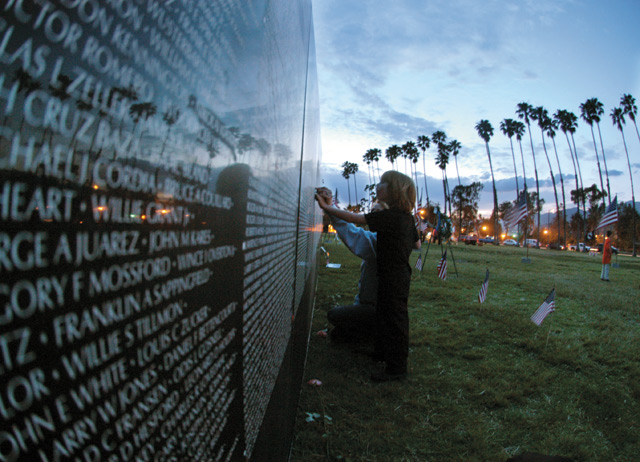Beacon of Healing and Forgiveness for Vietnam Vets
The Moving Wall Memorial Comes to Santa Barbara October 12-17

The Moving Wall, a traveling replica of the Vietnam Veterans Memorial in Washington, D.C., comes to Chase Palm Park (323 E. Cabrillo Blvd.) on Wednesday-Monday, October 12-17, displaying more than 58,000 names of those who died in service. The six-day vigil gives veterans and their families a chance to pay their respects, make a “rubbing” of the names, and engage with others about their experience.
Nearly a half century later, the Vietnam War remains controversial, from the reasons why the United States engaged and why we left to how the war affected veterans and the way they were received when they returned. “When you came back, you landed in the middle of the night, came off the plane — within three to five hours, you were out of the processing center, catching a bus or a flight,” remembers Peter Bie, president of the Vietnam Veterans of America Chapter 218. “You were tired, worn out; you’d been traveling for 18 hours maybe by the time you got to the States. And as you walk through the airport, there is not a civilian who says, ‘Welcome back.’”
Bie was one of the lucky ones of the 2.7 million who served during that two-decade-long conflict. But surviving was just step one: Post-traumatic stress disorder remains the legacy of Vietnam vets, and one of the main conditions treated by the Veterans Administration. Bie believes the Moving Wall provides a space of healing, a space for vets to come to terms with their condition and the hardship they faced.
“When the Vietnam vets come to the wall, whether it’s in D.C. or something like this, it is also moving emotionally,” explained Bie. “For the Vietnam vets to stand at the wall [and] see the names, they are confronting their own experience. … It becomes cathartic, a healing wall. It becomes a wall of reconciliation and, in many ways, becomes a wall of forgiveness.
“There were many things done in the name of war that many GIs carry that guilt with them,” he continued. “[Coming] to the wall, it’s an opportunity to ask for forgiveness, but also to forgive yourself for what you may have done. It doesn’t mean that your demons are necessarily going to go away, but you’re finding accommodation, and you can share that sense of spirit that pervades as people stand at the wall.”
A ceremony will be held at 11 a.m. on Saturday, October 15, where 98 names from Santa Barbara County will be read and honored with the customary bell-ringing. A candlelight vigil will be held the following evening, Sunday, October 16, at 6:30 p.m. In addition to a display of the Huey helicopter in use during the war, the healing art exhibition will also host various educational programs, both for the public and students of many ages.
“Come to the wall, first of all, to honor and remember the service of those who died,” said Bie, “but also the thousands upon thousands upon thousands who served during the war era … all coming home very much changed.”



